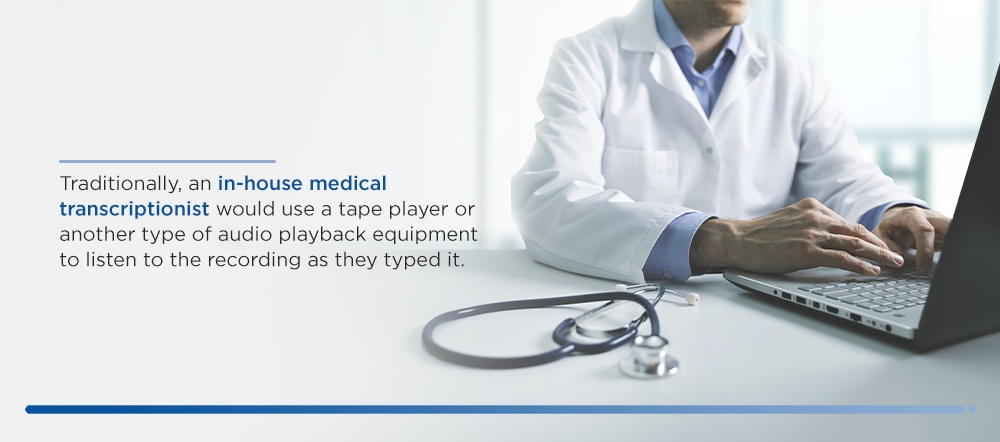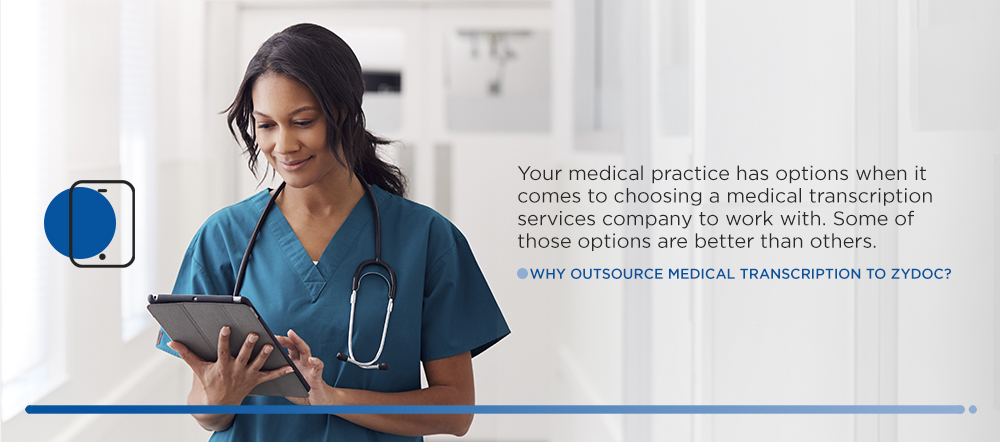Benefits of Outsourcing Medical Transcription
Oct 27, 2020 | Jonathan Maisel
Every time doctors or other healthcare providers see a patient, they make notes. The notes discuss the symptoms a person might be having, their current prescriptions and over-the-counter medications and what occurred during the encounter. Accurate notes are essential for ensuring a patient receives the care and treatment they need. To keep those notes from getting lost in the shuffle, someone needs to transcribe them and file them in the patient’s electronic health record (EHR).
Medical practices have two primary options when it comes to medical transcription. They can work with an in-house team of transcribers, or they can outsource transcription to a third party. While in-house transcription has some benefits, many medical providers may find outsourcing medical transcription services is the more cost-effective and efficient option.

Outsourcing vs. In-House Medical Transcription
Of the 58,000 people who worked as medical transcriptionists in the U.S. in 2018, 23% worked in-house in physicians’ offices and 21% worked in-house at hospitals. One-third were employed by companies that provide administrative and support services, such as transcription companies. When a transcriptionist works in-house, they are responsible for listening to a recording made by a medical provider, interpreting the recording and typing up or transcribing it.
Traditionally, an in-house medical transcriptionist would use a tape player or another type of audio playback equipment to listen to the recording as they typed it. Changes in technology have made the use of speech recognition software more common, though. Now, a medical provider is likely to dictate a note that is automatically transcribed by the software. A medical transcriptionist will review the typed up note, comparing it to the original recording. They will make any changes or corrections needed to the transcription to ensure it is accurate.
Working with an in-house transcriptionist has a few benefits. For example, an employee at the practice will become familiar with a doctor’s way of speaking, making it easier to decipher recordings and transcribe notes. They will also be easy to reach if there are questions or concerns about a particular transcription since they are likely to be in the same office. A medical practice can also train in-house transcriptionists to meet its standards and to always abide by privacy rules and laws.
Medical practices that keep transcription in-house often rely on their transcriptionist to perform other tasks. In addition to transcribing notes and documents, a transcriptionist might be expected to act as a receptionist, greeting patients who arrive for appointments or answering the phones in the office. Some also handle medical billing, order office supplies and perform other administrative tasks. Being expected to multitask throughout the day can prevent a person from performing their transcription duties as needed. They might feel that they need to rush through transcribing, leading to inaccurate or error-ridden notes. Or, they might have to put off transcription if the office is very busy.
Keeping medical transcription in-house can also be more expensive for a healthcare provider. If the practice or hospital has hired a person full-time, it will need to pay the employee’s salary, whether there are documents to transcribe or not. The practice will also typically provide payroll and pay unemployment insurance taxes for any employees it hires to do transcription.

Benefits of Outsourced Medical Transcription Services
For many medical providers, outsourcing transcription makes more sense than keeping it in-house. From reducing costs to ensuring there is always someone to transcribe important notes, there are many benefits of outsourcing medical transcription.
1. More Cost-Effective
Numerous costs are involved in hiring a person to provide in-house transcription. The average cost to hire a new employee is $4,129. This cost includes the time and money spent advertising for a position, time spent reviewing resumes and time spent interviewing candidates. The average company needs more than 40 days to fill a vacant or new position.
Once the transcriptionist is added to the team, your company needs to pay them even if there aren’t notes or documents to transcribe. That is one reason why many medical practices that use in-house transcriptionists usually have their transcription team perform other roles.
When your practice outsources transcription, you only pay for the material you have transcribed, usually on a per-line basis. If your practice doesn’t see patients for a week or so, you don’t have to worry about continuing to pay the salary of a person who doesn’t have any work to do. You also do not need to pay employee taxes or benefits when you outsource medical transcription.
2. No Need to Purchase or Maintain Equipment
Setting up and maintaining in-house transcription typically requires the purchase of equipment and software. If your team will transcribe documents from recorded voice files, they will need a way to easily playback as well as start and stop those files. Required playback equipment usually includes a foot pedal, headphones and an audio file player.
Using speech recognition software in-house also usually requires the purchase of equipment, such as the software itself and a microphone and recorder for doctors to use when making their notes. Along with investing in the equipment, you will need to spend time training your team on how to use it.
When you outsource transcription, all the equipment and software are kept off-site. You won’t have to purchase it, store it or worry about continually updating it. You also don’t have to dedicate hours or days to train your team on the proper use of the software or equipment.
3. Provides Access to Trained Personnel
Medical transcription is much more than simply typing up notes and memos. There is a lot of specialized jargon and vocabulary used in the medical field, and it is essential that transcriptionists are able to recognize and understand what a provider is saying in their voice file. Many transcriptionists complete a post-secondary certificate program or another type of training to learn how to transcribe and how to recognize and understand medical terms.
Depending on the company you work with, you can easily get access to trained and experienced transcriptionists. Working with individuals who understand medical terminology makes it more likely that your documents will be correct and accurate the first time around. Getting accurate patient notes right away helps improve the quality of care you offer patients and ensure they are getting the referrals, medications and treatments that are right for them.
4. Provides a Dedicated Service
Modern medical practices have a lot on their plates. They use their time to:
- Provide top-quality care to patients.
- Keep up with billing and insurance claims.
- Make sure patients’ files are kept up to date and orderly.
- Ensure the practice is in compliance with HIPAA and any other medical privacy laws and regulations.
Outsourcing transcription takes one thing off of that too-full plate.
When you partner with a company that provides medical transcription, you can trust you are going to get a dedicated service from that company. Unlike having an in-house transcriptionist who is also a receptionist and a medical coder and an administrative assistant, an outsourced company is going to be focused solely on providing you transcriptions. The singular focus means the company will be able to provide the best possible transcription, freeing your team up to focus on other equally important areas.
5. Makes It Easy to Keep up With Demand
The number of visits scheduled at your practice can vary throughout the year. The end of summer might be a busy time, as parents scramble to get their kids’ wellness check-ups in before the start of the school year. The time around the winter holidays might be much quieter. In the busy months, your team might have to hustle to keep up with the number of appointments scheduled and the extra responsibilities that come up when you are seeing a higher-than-average volume of patients.
During those busy times, you can feel confident knowing you have an outsourced team that is capable of keeping up with the elevated volume of notes and memos that need to be transcribed. Since you pay as you go with an outsourced transcription company, you can easily adjust the volume up or down as your practice demands. When times are slow, you don’t have to worry about laying off a transcriptionist. All you need to do is send fewer items to be typed up.
With an outsourced company, you also don’t have to worry about having to quickly find a substitute if one of your team members goes on vacation or calls in sick. Someone from the company you partnered with will always be available to transcribe your notes in a timely manner.
6. Easy to Get Started
When you work with an in-house team, there is definitely a learning curve, especially when your team is getting started. In addition to the time it takes to hire in-house transcriptionists, it can take weeks or even months before they are fully acclimated to the job and are able to work smoothly and efficiently. If your practice decides to upgrade or change the transcription equipment you use, the team might need a few weeks to train on it and become familiar with the software or equipment.
If you decide to outsource transcription, getting started is a lot easier. You don’t have to train people or vet people. You also don’t have to worry about installing complicated software or maintaining expensive equipment. In many cases, you’ll be able to use an app on a mobile device or a dedicated toll-free number to create and send in dictations.
7. HIPAA Compliant
The Health Information Portability and Accountability Act of 1996, better known as HIPAA, established privacy rule standards that are designed to protect sensitive patient information. The goal of the standards is to ensure that private information is protected while also allowing for the efficient flow of sensitive information between parties that need to know. It is particularly important that any organizations that handle patient data, such as transcription service providers, understand and comply with the HIPAA privacy rule.
When you outsource medical transcription, be sure to look for a company that stresses that it is HIPAA compliant, for the sake of your patients and your practice.
8. Minimizes the Risk of Burnout
Even during slow periods, you might look around your medical practice or walk the halls of a hospital and realize people are busy. All that busyness often leads to burnout, or exhaustion and reduced efficiency as a result of high levels of on-the-job stress. Burnout is prevalent in the healthcare industry and affects everyone from nurses and doctors to people in administrative positions. Finding ways to reduce the burden on your in-house team, such as by outsourcing what you can, may help bring down stress levels and minimize burnout.

Why Outsource Medical Transcription to ZyDoc?
Your medical practice has options when it comes to choosing a medical transcription services company to work with. Some of those options are better than others. For example, ZyDoc was founded by a practicing retina surgeon. Using our transcription system, our founder, Dr. James M. Maisel, is able to see more than 40 patients during a standard workday. Improved efficiency is just one reason to use ZyDoc.
Our system is also easy to set up and use. Medical providers at your practice can dictate their files using an app on a smartphone, a tablet or a voice recorder. They can also call a toll-free number and dictate their messages to it. Finished transcriptions are uploaded to a cloud-based, HIPAA-compliant software program. The program can be accessed on any device that connects to the internet. There is no need to download or install anything.
While our system is user-friendly and easy to set up, we also offer training and support for anyone on your team who needs it. We’re there to walk you through the process of recording files, uploading them and reviewing the finished documents. Our system can also be integrated with your practice’s existing EHR system, making it easy to file transcripts in the appropriate sections of a patient’s medical record.
Let ZyDoc Meet Your Medical Transcription Outsourcing Needs
When you use ZyDoc for medical transcription, you only pay for the amount you have transcribed, starting at 10 cents per line. Whether you have high a volume of files that need transcription or only need it occasionally, contact us today to see how outsourcing transcription can help you increase productivity and improve the quality of care you provide to patients.

